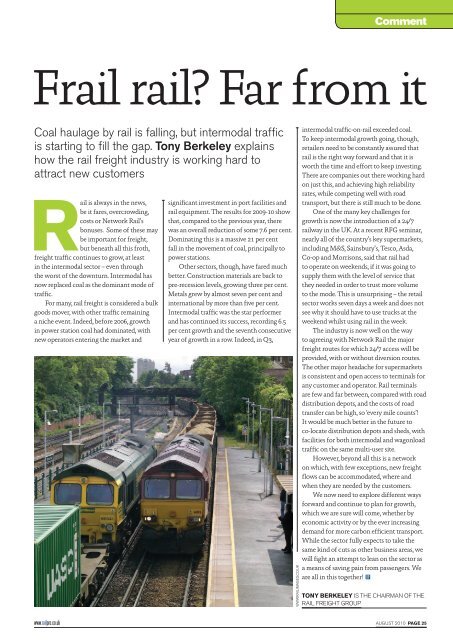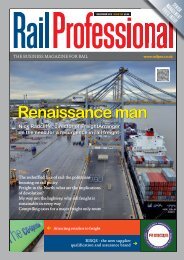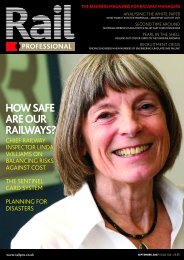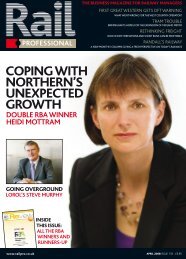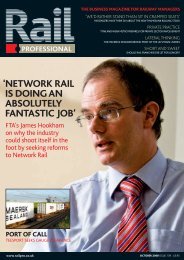View as PDF - Rail Professional
View as PDF - Rail Professional
View as PDF - Rail Professional
Create successful ePaper yourself
Turn your PDF publications into a flip-book with our unique Google optimized e-Paper software.
Comment<br />
Frail rail? Far from it<br />
Coal haulage by rail is falling, but intermodal traffic<br />
is starting to fill the gap. Tony Berkeley explains<br />
how the rail freight industry is working hard to<br />
attract new customers<br />
<strong>Rail</strong> is always in the news,<br />
be it fares, overcrowding,<br />
costs or Network <strong>Rail</strong>’s<br />
bonuses. Some of these may<br />
be important for freight,<br />
but beneath all this froth,<br />
freight traffic continues to grow, at le<strong>as</strong>t<br />
in the intermodal sector – even through<br />
the worst of the downturn. Intermodal h<strong>as</strong><br />
now replaced coal <strong>as</strong> the dominant mode of<br />
traffic.<br />
For many, rail freight is considered a bulk<br />
goods mover, with other traffic remaining<br />
a niche event. Indeed, before 2006, growth<br />
in power station coal had dominated, with<br />
new operators entering the market and<br />
significant investment in port facilities and<br />
rail equipment. The results for 2009-10 show<br />
that, compared to the previous year, there<br />
w<strong>as</strong> an overall reduction of some 7.6 per cent.<br />
Dominating this is a m<strong>as</strong>sive 21 per cent<br />
fall in the movement of coal, principally to<br />
power stations.<br />
Other sectors, though, have fared much<br />
better. Construction materials are back to<br />
pre-recession levels, growing three per cent.<br />
Metals grew by almost seven per cent and<br />
international by more than five per cent.<br />
Intermodal traffic w<strong>as</strong> the star performer<br />
and h<strong>as</strong> continued its success, recording 6.5<br />
per cent growth and the seventh consecutive<br />
year of growth in a row. Indeed, in Q3,<br />
WWW.RAILIMAGES.CO.UK<br />
intermodal traffic-on-rail exceeded coal.<br />
To keep intermodal growth going, though,<br />
retailers need to be constantly <strong>as</strong>sured that<br />
rail is the right way forward and that it is<br />
worth the time and effort to keep investing.<br />
There are companies out there working hard<br />
on just this, and achieving high reliability<br />
rates, while competing well with road<br />
transport, but there is still much to be done.<br />
One of the many key challenges for<br />
growth is now the introduction of a 24/7<br />
railway in the UK. At a recent RFG seminar,<br />
nearly all of the country’s key supermarkets,<br />
including M&S, Sainsbury’s, Tesco, Asda,<br />
Co-op and Morrisons, said that rail had<br />
to operate on weekends, if it w<strong>as</strong> going to<br />
supply them with the level of service that<br />
they needed in order to trust more volume<br />
to the mode. This is unsurprising – the retail<br />
sector works seven days a week and does not<br />
see why it should have to use trucks at the<br />
weekend whilst using rail in the week.<br />
The industry is now well on the way<br />
to agreeing with Network <strong>Rail</strong> the major<br />
freight routes for which 24/7 access will be<br />
provided, with or without diversion routes.<br />
The other major headache for supermarkets<br />
is consistent and open access to terminals for<br />
any customer and operator. <strong>Rail</strong> terminals<br />
are few and far between, compared with road<br />
distribution depots, and the costs of road<br />
transfer can be high, so ‘every mile counts’!<br />
It would be much better in the future to<br />
co-locate distribution depots and sheds, with<br />
facilities for both intermodal and wagonload<br />
traffic on the same multi-user site.<br />
However, beyond all this is a network<br />
on which, with few exceptions, new freight<br />
flows can be accommodated, where and<br />
when they are needed by the customers.<br />
We now need to explore different ways<br />
forward and continue to plan for growth,<br />
which we are sure will come, whether by<br />
economic activity or by the ever incre<strong>as</strong>ing<br />
demand for more carbon efficient transport.<br />
While the sector fully expects to take the<br />
same kind of cuts <strong>as</strong> other business are<strong>as</strong>, we<br />
will fight an attempt to lean on the sector <strong>as</strong><br />
a means of saving pain from p<strong>as</strong>sengers. We<br />
are all in this together!<br />
TONY BERKELEY IS THE CHAIRMAN OF THE<br />
RAIL FREIGHT GROUP<br />
AUGUST 2010 PAGE 25


